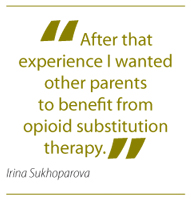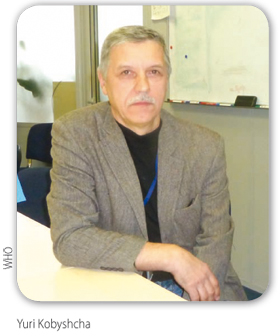NEWS
Opioid treatment in Ukraine risks losing momentum
Ukraine has made progress in introducing opioid substitution therapy since 2004, but the coverage of these services remains inadequate while injecting drug use continues to drive the country's HIV epidemic. Gary Humphreys reports.
Irina Sukhoparova first became aware that her daughter was taking drugs when Tatyana was in her early twenties. After the collapse of the Soviet Union in 1991, when Ukraine gained independence, small amounts of heroin started to be smuggled into the country via the Black Sea, the porous southern flank.
Then, during the 1990s, an illicit industry sprang up generating large quantities of another opioid drug a liquid made from the straw of poppies grown in Ukraine. Talking about her daughter's dependence on the highly addictive home-grown opiate, Sukhoparova says: "It was very hard for me, and Tatyana was very sick. It felt like very bad luck for us."
"We struggled with different kinds of therapy for six years, including detox and psychotherapy, but we didn't have much success. Then, in 2005, Tatyana read about an opioid substitution therapy programme in the newspaper. The programme was for 145 people, and we managed to get Tatyana on it."
By taking the longer acting but less euphoric opioid, buprenorphine, Tatyana managed to overcome the harsh withdrawal symptoms of coming off the liquid poppy straw in a supportive clinical environment. Buprenorphine, a medicine, taken once a day (usually in tablet form under the tongue) reduces craving for opioids and blocks the effects of illicit opioid use, thus avoiding the harm associated with dirty needles and unhygienically prepared liquid poppy straw. And, in Ukraine, this treatment is free.

The results were dramatic. "After just two or three months on treatment, Tatyana started to look like she did before she became hooked and she was generally much healthier," Sukhoparova recalls.
Tatyana was one of the first patients to participate in the country's first opioid substitution therapy programme, one that followed international treatment standards, including World Health Organization (WHO) guidelines.

"After that experience I wanted other parents to benefit from opioid substitution therapy," says Sukhoparova who set up Nadia i Dovira (Hope and Trust) in 2008, an association to support the parents of injecting drug users and to raise awareness that this is a treatable disease.
Since 2004, when the first pilots got under way in Ukraine, opioid treatment programmes have sprung up in other parts of the former Soviet Union, including Belarus, Georgia and the Republic of Moldova, but in most of these countries there has been and still is resistance to the idea of treating opioid dependence with this therapy.
Worldwide, few countries recognize dependence on illicit drugs as a health problem and even fewer provide effective treatment and care for it. "We estimate that opioid substitution treatment is reaching only 10% of people who need it," says Dr Nicolas Clark, medical officer in the Management of Substance Abuse unit at WHO in Geneva. Moreover, the stigma attached to drug dependence continues to be a major barrier to seeking treatment.
One of the people Sukhoparova had to thank for her daughter's recovery was Dr Sergey Dvoriak, the director of the Ukrainian Institute of Public Health Policy, and one of Ukraine's early proponents of opioid substitution therapy.
A psychiatrist by training, Dvoriak became interested in drug rehabilitation while working in the United States of America in 1986. When he returned to Ukraine, he established one of the first drug rehabilitation centres in eastern Europe, the Stupeni ("steps") centre in 1991. Dvoriak soon realized, however, that "rehab" was not enough and that providing effective treatment for people who inject illicit drugs in Ukraine was a crucial part of containing the country's HIV epidemic.
In 2005, he was instrumental in setting up the Ukrainian Institute of Public Health Policy, a non-profit organization created by doctors and psychologists to design and implement evidence-based approaches to dealing with drug dependence and the rehabilitation of drug users, including those living with HIV.
The Institute's work includes basic and applied research, but also promotes self-help programmes and the social, occupational and psychological rehabilitation of patients. "The Institute also works with other drug problems and alcohol abuse, but opioid addiction is our priority because the majority of people who inject drugs use opioids and because it's a treatable disease," Dvoriak says.
Like everywhere, it is impossible to know exactly how many people inject illicit drugs in Ukraine, a country of some 45 million people.
A survey in 2006 by Ukrainian researcher Olga Balakireva and colleagues, suggested that there could be as many as 560 000 in the east European country while, according to the International HIV/AIDS Alliance in Ukraine, there were between 278 000 and 387 000 in 2010 a staggering one quarter of those were under 18 years.
Not only is Ukraine's injecting drug problem a social ill, leading to the impoverishment of users, who turn to crime and prostitution to pay for the next fix, and to the break-up of families, it is also the main factor driving the country's HIV epidemic. HIV prevalence among the country's injecting drug users stands at around 21.5%, while some 45% of the total number of the registered 221 806 cases of HIV became infected with the virus by injecting drugs, according to the Ukrainian AIDS Centre of the Ministry of Health.
Numerous studies have drawn attention to the risky way in which people obtain illicit opioids in Ukraine. Sometimes the liquid poppy straw is bought in pre-loaded syringes from dealers, who are often injectors themselves, or from dealers who allow users to extract it from jars directly into their own syringes, so that in a single day many recycled needles and syringes can be used to extract the liquid from one vessel thus increasing the risk of transmitting infections, such as hepatitis viruses and HIV.

Since the Institute was set up, Dvoriak says that the Ukrainian government has increased its support for such work. In 2008, it launched a new series of pilots that take an integrated approach to the problem by providing treatment for HIV infection and other health-care services, where these are needed, alongside opioid substitution therapy. These pilots, which started in Dnipropetrovsk, Mykolaiv and Odessa regions, as well as in the capital, Kiev, are being scaled up and established as key elements of the national AIDS programme.

While all of the country's opioid substitution programmes are run in government institutions, the Global Fund to Fight AIDS, Tuberculosis and Malaria funds supplies of buprenorphine, the medicine that was used to start the programme, and methadone, which was added in 2007 and is now the main medicine used for this treatment in Ukraine. The Global Fund also funds psychosocial support for recovering patients, through local nongovernmental organizations.
As a result of these initiatives, the number of people on opioid substitution therapy has increased threefold in three years from 2504 in early 2009 to 7090 receiving treatment in 143 facilities by mid-2012, according to the Institute of Public Health Policy.
Dvoriak is concerned, however, that despite this modest but undeniable progress, there is a risk that opioid substitution therapy is losing momentum. "We have formal support for opioid substitution therapy from the state, but it is not translated into adequate and sustainable funding to ensure the access to and good coverage of opioid substitution therapy in the country," he says.
Dr Yuri Kobyshcha, who works in the WHO Country Office in Kiev, concurs. "There is a lack of funding for opioid substitution therapy," he says "We are reliant on the US$ 1.5 million committed by the Global Fund each year. This is not sustainable in the long term."
"People with tuberculosis and HIV or those suffering from drug dependence often live on the margins of society. They fear that if they seek treatment they will become stigmatized," he says, adding that this is not the only disincentive for seeking treatment.
In 20102011, the policing of opioid substitution therapy clinics was stepped up to prevent the diversion of methadone and buprenorphine, although these are taken under supervision of staff at these clinics and unlike the regimen in some countries cannot be taken home.
While the situation has eased slightly since then, the upshot of these hindrances is that the programme is missing targets, argues WHO's Kobyshcha. "With only 2.6% (7000) of the injecting drug population receiving opioid substitution therapy, the National AIDS Programme target of getting 20 000 of them on the programme by the end of 2013 is unlikely to be reached," he says.
"The police take a very hard line on illegal substances and so doctors are afraid of treating people who inject drugs," Dvoriak says. "As one doctor put it 'opioid substitution therapy improves patients' quality of life, but worsens the quality of life of the medical staff'." 
